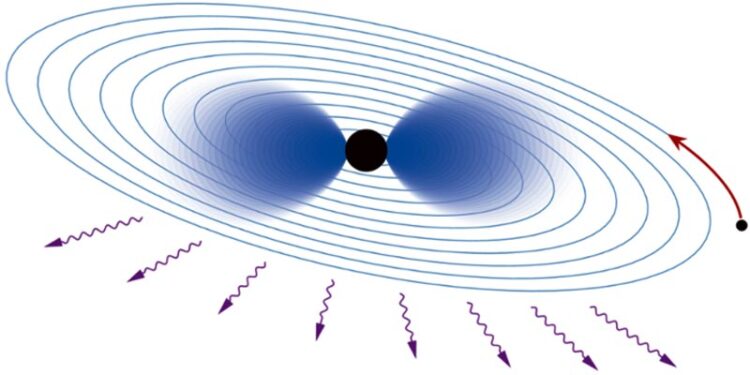Detecting new particles around black holes with gravitational waves

An atom in the sky. If new ultralight particles exist, black holes would be surrounded by a cloud of such particles that behaves surprisingly similar to the cloud of electrons in an atom. When another heavy object spirals in and eventually merges with the black hole, the gravitational atom gets ionized and emits particles just like electrons are emitted when light is shone onto a metal.
Credit: UvA Institute of Physics
Clouds of ultralight particles can form around rotating black holes. A team of physicists from the University of Amsterdam and Harvard University now show that these clouds would leave a characteristic imprint on the gravitational waves emitted by binary black holes.
Black holes are generally thought to swallow all forms of matter and energy surrounding them. It has long been known, however, that they can also shed some of their mass through a process called superradiance. While this phenomenon is known to occur, it is only effective if new, so far unobserved particles with very low mass exist in nature, as predicted by several theories beyond the Standard Model of particle physics.
Ionizing gravitational atoms
When mass is extracted from a black hole via superradiance, it forms a large cloud around the black hole, creating a so-called gravitational atom. Despite the immensely larger size of a gravitational atom, the comparison with sub-microscopic atoms is accurate because of the similarity of the black hole plus its cloud with the familiar structure of ordinary atoms, where clouds of electrons surround a core of protons and neutrons.
In a publication that appeared in Physical Review Letters this week, a team consisting of UvA physicists Daniel Baumann, Gianfranco Bertone, and Giovanni Maria Tomaselli, and Harvard University physicist John Stout, suggest that the analogy between ordinary and gravitational atoms runs deeper than just the similarity in structure. They claim that the resemblance can in fact be exploited to discover new particles with upcoming gravitational wave interferometers.
In the new work, the researchers studied the gravitational equivalent of the so-called ‘photoelectric effect’. In this well-known process, which for example is exploited in solar cells to produce an electric current, ordinary electrons absorb the energy of incident particles of light and are thereby ejected from a material – the atoms ‘ionize’. In the gravitational analogue, when the gravitational atom is part of a binary system of two heavy objects, it gets perturbed by the presence of the massive companion, which could be a second black hole or a neutron star. Just as the electrons in the photoelectric effect absorb the energy of the incident light, the cloud of ultralight particles can absorb the orbital energy of the companion, so that some of the cloud gets ejected from the gravitational atom.
Finding new particles
The team demonstrated that this process may dramatically alter the evolution of such binary systems, significantly reducing the time required for the components to merge with each other. Moreover, the ionization of the gravitational atom is enhanced at very specific distances between the binary black holes, which leads to sharp features in the gravitational waves that we detect from such mergers. Future gravitational wave interferometers – machines similar to the LIGO and Virgo detectors that over the past few years have shown us the first gravitational waves from black holes – could observe these effects. Finding the predicted features from gravitational atoms would provide distinctive evidence for the existence of new ultralight particles.
Journal: Physical Review Letters
DOI: 10.1103/PhysRevLett.128.221102
Method of Research: Observational study
Subject of Research: Not applicable
Article Title: Detecting new particles around black holes with gravitational waves
Article Publication Date: 2-Jun-2022
Media Contact
Nick Beston
Universiteit van Amsterdam
n.r.beston@uva.nl
Office: 0031-205-252-695
All latest news from the category: Physics and Astronomy
This area deals with the fundamental laws and building blocks of nature and how they interact, the properties and the behavior of matter, and research into space and time and their structures.
innovations-report provides in-depth reports and articles on subjects such as astrophysics, laser technologies, nuclear, quantum, particle and solid-state physics, nanotechnologies, planetary research and findings (Mars, Venus) and developments related to the Hubble Telescope.
Newest articles

Innovative 3D printed scaffolds offer new hope for bone healing
Researchers at the Institute for Bioengineering of Catalonia have developed novel 3D printed PLA-CaP scaffolds that promote blood vessel formation, ensuring better healing and regeneration of bone tissue. Bone is…

The surprising role of gut infection in Alzheimer’s disease
ASU- and Banner Alzheimer’s Institute-led study implicates link between a common virus and the disease, which travels from the gut to the brain and may be a target for antiviral…

Molecular gardening: New enzymes discovered for protein modification pruning
How deubiquitinases USP53 and USP54 cleave long polyubiquitin chains and how the former is linked to liver disease in children. Deubiquitinases (DUBs) are enzymes used by cells to trim protein…


